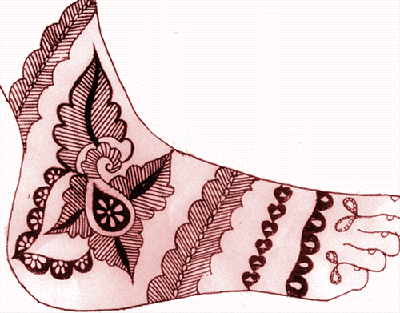

Mehandi is the Hindi word for a beauty treatment involving the crushed leaves of the henna plant. The leaves of this plant, when mixed with essential oils and water and applied to hair or skin, leave a beautiful reddish-brown stain that can last from several days to several weeks.
Also called mehandi or henna, mehndi has been a tradition in India, Africa, Eastern Europe and the Middle East for thousands of years. Women in these cultures ornament themselves with mehndi for weddings and other celebrations. The mehndi paste is piped onto the skin in ornate patterns, then kept moist as long as possible with lime juice, eucalyptus oil and sugar to allow the stain to deepen.

Mehndi is one of the sixteen adornments bestowed on a bride during Solah Shringar. In this way, mehndi marks the rite of passage of marriage in a girl's life and her initiation into womanhood.The intricate mehndi designs, which are painted on both the hands and feet, may contain a secret language. Designs include geometric and figurative motifs such as flowers and leaf and vine patterns, and traditional hindu religious symbols. Mehndi symbolizes satisfaction and happiness in marriage. This belief is connected with its red color which is also the color of the bride's dress. The process of applying the designs takes on a ritualistic aspect.
The mehndi is applied to the bride's hands and feet the night before the marriage ceremony by the bride's female relatives who spend several hours applying the designs. The process may take anywhere from three to eight hours depending upon the complexity of the designs and whether or not both the hands and feet are decorated.

Top Stories
Subscribe Now
Search more fashion here

Custom Search
Labels
- 2009 Trends (1)
- aishwarya rai (1)
- anarkali suits (1)
- Antique Jewels (2)
- Bindi (6)
- boots (1)
- boys sherwani (1)
- boys wear (1)
- Bracelets (1)
- Catwalk (1)
- cellphone bags (3)
- Choli (6)
- christmas (3)
- clutches (1)
- contact lenses (1)
- cosmetics (1)
- cotton collections (1)
- Dandiya dress (1)
- Diamond Necklaces (1)
- diwali (2)
- Diwali 2010 fashion sarees (1)
- diwali 2011 latest designer sarees collections (2)
- diwali 2012 salwar kameez (1)
- diwali 2012 saree (1)
- embroided sarees (1)
- Fancy Sarees (1)
- fashion accessories (9)
- Fashion designing (2)
- fashion shows (8)
- Femina Miss India 2011 (1)
- flower girl dresses (2)
- gerogette sarees (2)
- girls dress (1)
- Girls tops (1)
- gold (1)
- Grooms - Wedding Collection (6)
- Hair coloring (1)
- Hairstyles (3)
- henna (2)
- i-shadow (1)
- Jewellery (4)
- Jovani dresses (1)
- Kids wear (5)
- kurtis (3)
- Ladies Handbags (9)
- lakme fashion week 2012 (2)
- Latest georgette Salwar kameez (1)
- Leggings (2)
- lehenga sarees (1)
- Lehengas (3)
- Light party saree (1)
- Lipsticks (1)
- Makeup tips (2)
- Mehendi (11)
- Miss Universe 2011 (1)
- miss world 2011 (2)
- Necklaces (1)
- Onam 2011 (1)
- onam2012 (1)
- Party Wear Collection (3)
- Party wear Saree (6)
- Parx Gallery (1)
- Pendants (2)
- Pink costumes (1)
- Punjabi suits (2)
- Ra one costumes (1)
- Raksha bandhan rakhis (1)
- ramzan collection (1)
- Rangoli (1)
- Review (1)
- Salwar kameez (4)
- Sarees (8)
- shoes (5)
- skirts (1)
- spring2012 (1)
- spring2013 (1)
- Stars dress (1)
- T-shirts (1)
- tatoos (1)
- Tattoos (11)
- valentines day wear (1)
- verifi (1)
- wallets (1)
- watches (6)
- Wedding collection (7)
- Women's festival (1)